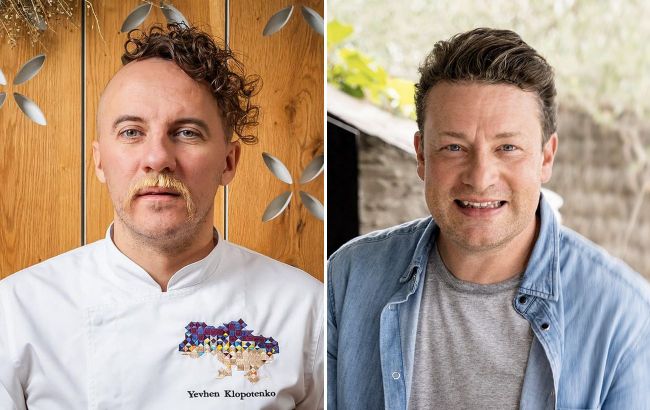Ukraine beats the UK at school lunch reform - and no one saw it coming
 School lunch reform in Ukraine began in 2020 (collage: RBC-Ukraine)
School lunch reform in Ukraine began in 2020 (collage: RBC-Ukraine)
In 2020, Ukraine launched a school nutrition reform initiative led by chef Yevhen Klopotenko. From the very beginning, it faced a wave of criticism. However, Ukraine’s experience is not new to the world - back in 2005, British chef Jamie Oliver followed the same path. Why did the reform fail in the UK while continuing to work in Ukraine?
Key questions:
- How Jamie Oliver promote school meal reform?
- What caused the failure of his reform?
- Why did Yevhen Klopotenko’s innovations provoke a sharp public reaction?
- What's the current stage of the reform in Ukraine?
A team of scientists from the University of Washington concluded during an analytical study that by 2050, more than half of the world’s adults and one-third of children and young people will be overweight or obese.
Currently, 493 million children and young people aged 5 to 24 are overweight or obese. In 1990, that number was 198 million.
Nutrition is fundamental to a healthy weight, and its foundation is laid in the family and at school. Understanding this and anticipating a global problem, renowned chefs Jamie Oliver and Yevhen Klopotenko undertook to reform school meals in their respective countries.
What is known about Jamie Oliver
Jamie Oliver is a renowned English chef, restaurateur, author of globally popular cookbooks and TV shows about cooking, entrepreneur, and public figure, as well as a promoter of healthy eating and an active advocate for food education.
Jamie Oliver’s books, including "30-Minute Meals," "Cook with Jamie," and "Everyday Super Food", were translated into Ukrainian.
Jamie earned the nickname "The Naked Chef," which comes from the name of his first television show. His career began as a pastry chef at the Neal Street Restaurant under famed chef Antonio Carluccio.
In 1997, Jamie debuted in the BBC documentary project "Christmas at the River Café," which viewers greatly enjoyed. From that moment, his popularity soared. The profits of Jamie Oliver’s business group made him the richest Brit under 30 at the time.
 Famous British chef Jamie Oliver (photo: facebook.com/jamieoliver)
Famous British chef Jamie Oliver (photo: facebook.com/jamieoliver)
School nutrition reform in the UK
In 2005, Jamie Oliver launched the "Feed Me Better" campaign to encourage British schoolchildren to give up junk food and switch to healthy eating.
At the time, school menus included burgers, sausage rolls, fish sticks, nuggets, chips, vanilla pudding, French fries, and turkey sausage, with barely any poultry in it, as well as other fatty foods. A school lunch cost 37 pence then, equivalent to about $0.43 today.
Oliver's approach was unique in that he didn’t just talk about the new menu—he cooked in a school for several months as an experiment. The process was filmed for his documentary series "Jamie’s School Dinners."
Afterward, the UK government and then-Prime Minister Tony Blair promised to improve school meals. The government allocated £280 million for the reform over three years. And about £500 million was spent on reform efforts between 2005 and 2011.
Let’s compare the menus before and after the reform. Previously, lunch included a cheeseburger, baked beans, chips, jelly candies, ice cream, and a soda.
After Oliver's changes, the menu looked like this: salmon fish sticks with tomato sauce, half a baked potato in its skin, salad, fruit with yogurt, and semi-skimmed milk. This new menu had 619 calories compared to the previous 1,170.
Despite Oliver’s efforts, by 2019, the UK still ranked among the 20 countries with the highest obesity rates. Researchers from the Jamie Oliver Foundation found that many schools continued to serve foods high in fat and sugar. Oliver later admitted that his efforts to improve children’s nutrition had failed.
What caused the reform’s failure
As of July 2009, over 400,000 children had opted out of school lunches. Only 39% and 35% of students in primary and secondary schools, respectively, consumed school meals. Before the reform, coverage across the country was 45% for both levels.
There were several reasons. First was the rise in lunch prices. Before the reform, a meal cost 37 pence (about $0.43), but afterward, primary school meals cost at least 50 pence ($0.58), and secondary school meals cost 60 pence ($0.70).
Parents complained that portions were too small and children weren’t getting full. In a Netflix documentary, Oliver described how parents would demonstratively give children fast food or even pass it to them through the school fence.
A third reason was the lack of support and government criticism of Oliver’s initiative, particularly from Health Secretary Andrew Lansley and politician David Laws. Laws stated that the government rushed to implement new food standards before assessing whether children would eat the new meals.
Lansley, in turn, claimed that eating habits are formed at home, so schools could not retrain children and parents unfamiliar with healthy eating. However, Professor Alan Maryon-Davis, president of the UK Faculty of Public Health, defended Oliver.
"I think what Jamie Oliver did was great. It improved school meals and pushed the government to invest in them," he said.
 Jamie Oliver's reform faced criticism, including from government representatives (photo: facebook.com/jamieoliver)
Jamie Oliver's reform faced criticism, including from government representatives (photo: facebook.com/jamieoliver)
How the reform ended
In 2015, the government introduced school meal standards and banned confectionery, limiting pastries and sugar intake. Schools were obliged to offer one or more vegetable or salad servings as a side dish daily.
In 2017, funding for the reform ended, although research from the University of Essex showed that healthier food improved students’ academic performance. Some schools still strive to provide good-quality meals today.
Currently, UK public schools are obliged to follow nutritional standards that mandate serving fruits and vegetables daily, using whole grains, and limiting fried foods to no more than twice a week. Oily fish (such as mackerel or sardines) must be offered at least once every three weeks.
Yevhen Klopotenko’s school nutrition reform
In reality, Klopotenko’s school meal reform began in 2017, though he conceived the idea after winning the show "MasterChef."
"I remember what they fed us in the school cafeteria. You’ll be surprised, but my mom had the same menu during her school years. After winning "MasterChef," I visited a school cafeteria in Kyiv, and the cooks were still using the Soviet recipe book from 1957 (republished in 1987). That day, I decided I would change that," Klopotenko recalls.
According to him, food conveys information. So by eating "Leninhrad-style rassolnik," kids were learning about a city that no longer exists.
 Klopotenko's initiative began in 2017-2018, officially at the state level in 2020 (photo: facebook.com/yevhen.klopotenko)
Klopotenko's initiative began in 2017-2018, officially at the state level in 2020 (photo: facebook.com/yevhen.klopotenko)
The first step was creating a new recipe book for schools. In 2018, Klopotenko’s NGO "CultFood" developed the "New School Recipe Book", which by 2019 was used in 5,000 schools across Ukraine.
"The main goal was to make children’s meals more varied—not pasta and cutlet every day, but various vegetables and fruits, different kinds of meat, fish, and a wide selection of side dishes," Klopotenko explains.
The reform reached the national level, accompanied by legislative changes, in 2020.
Public reaction to Klopotenko’s reforms
As usual, social media, parents, and teachers are split into groups of supporters and critics.
- "Every day, kids are poisoned with this junk. My son refuses to eat any of it! And they raised the price, too, profiting off of everything."
- "Klopotenko’s menu is just renamed dishes. Nuggets? That’s just chicken cutlets in egg batter or fish in egg."
- "I looked at the recipes in that book. It’s online. My colleagues and I didn’t find even one dish we’d want to cook at home."
- "Klopotenko cared so much about our kids that now they spit out his food. Does he even eat it himself?"
- "How is chicken now any healthier than sausage or hot dogs? Just wondering."

Screenshot
Despite considerable criticism and pushback, Klopotenko takes it in stride. He says he'd be more concerned if there were no negative reactions.
"Any reform always faces resistance—it’s how the human brain sees change as a threat. You can’t change meals in 15,000 schools overnight. There will always be misunderstandings," he explains.
One common complaint was the alleged absence of salt and sugar. Klopotenko admits he pushed for a reduction in these.
"In some canteens, they removed all salt and sugar. Naturally, kids didn’t want to eat that. Another issue is the generally low level of eating culture and awareness of healthy eating basics. What good is tea with sugar for a child? The state needs to run a public awareness campaign," he suggests.
However, the reform cannot be called a complete failure, as there were also satisfied users.
- Children go to the cafeteria with pleasure. The price of 30 UAH is just a dream! There are not enough fruits. Give your child a fragrant apple from home.
- My son finally started eating salads at school! He didn't like fish cutlets before, but now they cook them the way he likes. He says chops are the best. He also eats most of the side dishes and is always happy to get fruits, although he doesn't like all the drinks. But is it possible to please everyone?
- I believe that the menu is healthier. Another question is how it's cooked and who likes what, because there have always been dissatisfied people, for as long as I can remember.
- I'm not a fan of Klopotenko, but the menu at my child's kindergarten fully satisfies me. It's balanced and healthy for the budget allocated by the state. I’m glad my child no longer eats semolina on water, colored to look like milk and a sausage with pasta.
- Our school has the Klopotenko menu. Children eat with pleasure. A lot depends on the cook and what the child eats at home. If parents teach the proper nutrition basics from an early age, the child will eat at school, too.
.jpg)
.jpg)
.jpg)
.jpg)
Screenshots
Yevhen Klopotenko's team took public feedback into account.
"After the reform was launched in 2021, I had a clear plan. It included developing a new recipe collection that would give cooks a huge variety of dishes, training cooks, and a large information campaign on healthy eating supported by UNICEF," the chef said.
Current stage of the reform
The transition period for updating procurement systems and implementing new flowcharts ended on January 1, 2022. The updated school cafeteria menu consists of 160 dishes.
Some key requirements from the menu:
- Reduce the amount of sugar by 2–2.5 times, to 7.5 g per meal
- Increase the amount of fruit to 100 g per meal
- Reduce the amount of bread per meal to 30–50 g
- Increase the amount of poultry so that during a five-day school week with one meal per day, students receive two servings of meat weighing 70 g, 100 g, or 120 g each, depending on the age of the children
- Increase the amount of dairy products in the menu formulation
In addition, approximately 75% of the food in cafeterias should be plant-based: vegetables, salads, cereals, fruits, and berries. Schools must prioritize whole grain baked goods with a high fiber content, with added bran and seeds.
Only iodized salt is allowed and only for cooking. Sauces and mayonnaise are prohibited, except for ketchup with a high tomato content per 100 grams of the product.
Moreover, dishes may include peeled nuts or seeds, but this must be indicated in the menu so that children with food allergies are aware.
The latest recipe collection for educational institutions contained over 600 dishes. It was released in 2024 and became the third such collection for schools. All the wishes of parents and children were taken into account, as the team surveyed them before starting work.
"Additionally, over the three years since the presentation of the first collection (the first collection of 180 dishes was released in 2021 –ed.), we received a huge number of responses from students, parents, and cooks from all over Ukraine. These constructive suggestions were so helpful in our work," the chef emphasized.
He added that just last year, together with the Swiss-Ukrainian project DECIDE and USAID, they trained nearly 400 qualified vocational instructors, who will train over 2,000 school cafeteria cooks.
This will significantly improve the quality of school meals at the local level. As a result, students will receive tasty and, most importantly, healthy food.
The full-scale Russian invasion has had an impact, particularly in that not all children can eat properly in shelters during constant air raids, so the reform has somewhat slowed down. But active work is ongoing on this aspect as well.
According to the initiator, Yevhen Klopotenko, currently, several options are available. One of them is catering.
"Schools can work directly with catering companies that prepare meals according to school menu standards. Catering can be ordered not only from private companies. Another educational institution can do it if it can cook for several schools," the chef said.
One school can join several others and cook meals in one kitchen block. Afterward, the meals are delivered directly to partner educational institutions.
Additionally, during 2024–2025, there has been a trend where educational institutions are reducing the use of the basic kitchen model. Instead, models such as the "hub kitchen" and "factory kitchen" are becoming increasingly popular.
Expansion of the free meal program
According to the Ministry of Education and Science, since October 2024, the government has been allocating a subsidy for the organization of free hot meals for primary school students. However, more changes are ahead.
- From September 2025, all students in grades 5–11 in frontline and border regions will receive free meals.
- Starting September 2026, the program will be extended to grades 5–6 throughout all regions of Ukraine.
- The program will gradually expand to other grades throughout the country in the following years.
Earlier, we wrote about three school habits that can predict your future weight.
Sources: Ministry of Education and Science of Ukraine, State Service of Ukraine on Food Safety and Consumer Protection, exclusive comments from chef Yevhen Klopotenko, Daily Mail, The Independent, research from the AKO Foundation, The Guardian, School Meals and Nutritional Standards.

